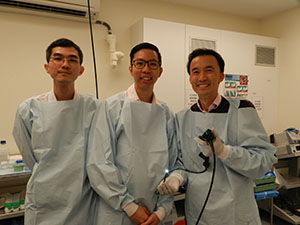
Two respiratory physicians from Singapore have visited St Andrew’s War Memorial Hospital, Brisbane, to learn more about bronchial thermoplasty, an innovative, minimally-invasive treatment for people with severe asthma.
Dr Adrian Chan Kwok Wai from Singapore General Hospital, and Dr Wong Hang Siang from Changi General Hospital, yesterday (4 June) observed three bronchial thermoplasty procedures performed by St Andrew’s respiratory physician Dr Samuel Kim with the team in the hospital’s endoscopy centre.
St Andrew’s was the first hospital in Queensland, and on Australia’s eastern seaboard, to offer this new treatment when procedures began in July last year. Performed under light anaesthesia, bronchial thermoplasty (BT) delivers controlled radiofrequency (RF) energy to a patient’s lung airways to gently heat and shrink the smooth muscle in the airway wall.
“People with severe asthma have abnormally thick smooth muscle circling their airways and this smooth muscle contracts during an asthma attack, squeezing the airways and constricting breathing,” Dr Kim said. “Once we decrease the smooth muscle there is less narrowing of the airways during an asthma attack and less likelihood of a severe attack.”
Patients receive three separate BT treatments several weeks apart - one for each lung’s lower lobe, and the third for the upper lobes of both lungs. The RF energy is delivered via an expanding catheter inserted into a standard flexible bronchoscope, which is introduced into the lung via the patient’s nose or mouth. Each treatment takes up to an hour.
“This procedure is indicated for adults with severe asthma, who are on heavy doses of steroids and preventers, who have persistent asthma symptoms, and who find they have to go to hospital emergency several times a year because of difficulty in breathing,” Dr Kim said. “Asthma severely affects these patients’ quality of life. Bronchial thermoplasty is not an asthma cure. It aims to improve a person’s quality of life, reduce their severe asthma attacks, reduce their admissions to hospital and their dependence on steroids and other medications.”
Dr Adrian Chan Kwok Wai and Dr Wong Hang Siang said they were keen to learn as much as possible about the treatment during their visit to St Andrew’s.
“This is the first time we have seen bronchial thermoplasty performed, so we have much to learn about it,” Dr Chan said. “The clinical data shows it is a promising treatment for severe asthma. We are observing here that the procedure is very well tolerated by patients.”
A study published in September last year in The Journal of Allergy and Clinical Immunology in the United States showed that five years after bronchial thermoplasty treatment, patients had an average 48 per cent decrease in severe asthma attacks and an average 88 per cent decrease in visits to hospital emergency rooms. *
The Global Initiative for Asthma (GINA) last month (May) updated its evidence-based Global Strategy for Asthma Management and Prevention to include bronchial thermoplasty as a treatment consideration for selected adult patients with uncontrolled asthma.
According to figures from the Australian Bureau of Statistics and the Australian Institute of Health and Welfare, more than 2 million people in Australia suffer from asthma, and in 2011 it caused 378 deaths and 37,830 hospitalisations.
*Wechsler ME et al.: Bronchial thermoplasty: Long-term safety and effectiveness in patients with severe persistent asthma. The Journal of Allergy and Clinical Immunology. Published online September 3, 2013.